Photo
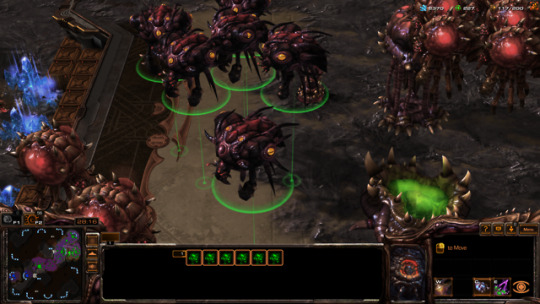


Overseer — Starcraft II
In Starcraft II, the slow, blimp-like Zerg Overlords gained the ability to metamorphose into Overseers: Similarly blimp-like aliens with lots of eyes and the ability to spot hidden enemies.
There probably is no more classically effective way of communicating “this creature is good at seeing” than by giving it a bunch of big, bright eyeballs. These eyes have a very Sauron-like quality to them, which is appropriate since the Zerg are mostly villains of the Starcraft franchise. Like all of the Zerg units, the Overseer mixes meaty and insectoid elements in a somewhat icky, very alien way.
An interesting feature of most real-time strategy games is that their sense of scale is usually pushed completely out of proportion for gameplay purposes. The Overlord and Overseer are canonically much bigger than most other Zerg units, despite appearing only slightly larger than many of those units on the field. Even so, their wide, bulky appearance helps to communicate this somewhat.
Fun fact: The illustration above was created by Luke Mancini as fan art in anticipation of Starcraft II’s release, and became retroactively official after he was hired to work at Blizzard.
Edit: This post previously implied that Overseers, like Overlords, could act as a transport for other units. They cannot. This error has been corrected.
55 notes
·
View notes
Photo
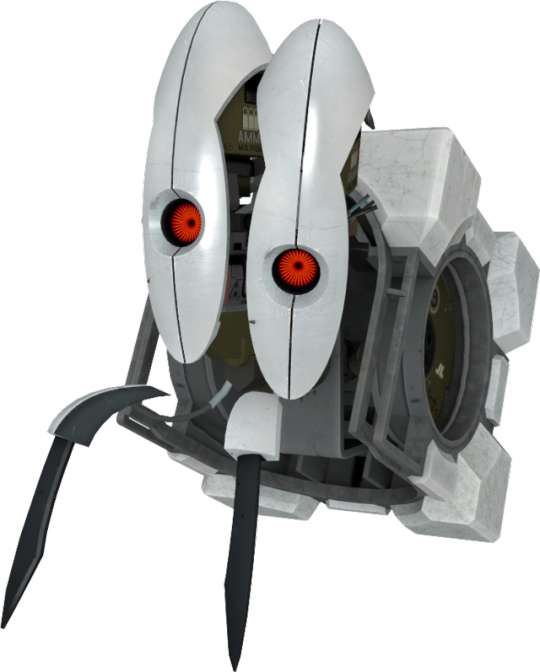


Frankenturret — Portal 2
Portal 2′s Frankenturrets (as they are referred to in developer commentary) were cobbled together to solve puzzles by an AI designed to produce bad ideas. Predictably, they aren’t very good at solving puzzles.
Portal’s turrets are small and cute, and funny because of how that cuteness is juxtaposed against their deadliness. By stripping them of their weapons (and their voices) and combining them with one of Portal’s weighted cubes, they are made sort of pitiful. They don’t move much, and their movement is awkwardly calculated using in-game physics. When the player picks one up, it retreats into its box like a hermit crab and shivers a bit.
Despite being completely harmless, the Frankenturrets are probably more unsettling than the turrets. They act as an indicator of how the game’s antagonist is managing to ruin absolutely everything in the Aperture Science facility.
137 notes
·
View notes
Photo

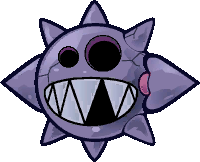

Bristle — Paper Mario: The Thousand-Year Door
In Paper Mario: TTYD, Bristles are enemies that are invulnerable to Mario’s standard jump and hammer attacks. Some things I like about this design:
• The two big spikes on their sides are extendable, so they can poke outward for an extra visual punch if a character attempts an attack from the ground.
• The missing tooth creates a bold, dark triangular hole, making the Bristle look even spikier than it would with a full set of teeth. This old, lopsided, broken aesthetic is carried into the rest of the design by the mismatched eye holes and cracks. Note also how the shading is crooked and angular, despite the geometrically clean outlines.
• The way that the Bristle is encircled in spikes leaves it balancing on a single point. Swaying back and forth on this point gives the Bristle some good idle animation, despite its relative lack of articulations.
118 notes
·
View notes
Photo
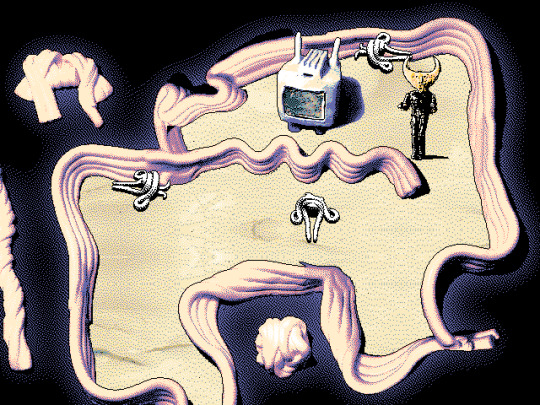

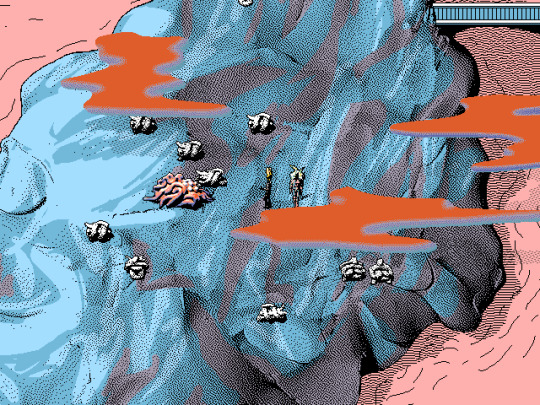
Bugs — Hylics
In the words of its creator, Mason Lindroth, “Hylics is a recreational program with light JRPG elements”. It features an absurdist, pastel-coloured world with an aesthetic that blends claymation and pixel art.
The ‘bugs’ in Hylics appear to have been made as clay sculptures, and they’re mostly relatively abstract arrangements of noodle-like shapes. They are generally inconspicuous and unobtrusive, merely acting as ambient wildlife until the player’s party gains the ability to collect them as a resource. Their small size and lack of colour denote their relative unimportance, but their movement is enough to liven up otherwise static scenes.
For an animated gif of these things, check out Mason Lindroth’s Tumblr HERE
402 notes
·
View notes
Photo
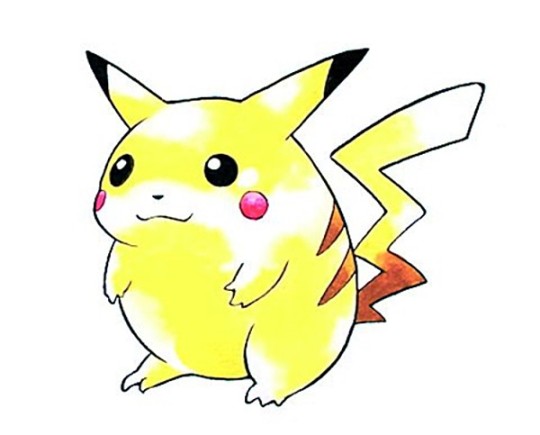




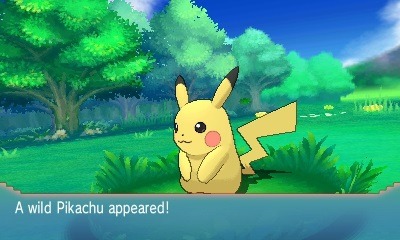


Pikachu — Pokémon Red/Blue
As the mascot for the highest-grossing media franchise ever, Pikachu is easily one of the most recognisable pop culture creatures of all time.
Many of Pokémon’s first-generation designs were relatively simple riffs on real creatures, and Pikachu is explicitly designed as a rodent with electricity powers. Although considered a “mouse Pokémon”, designer Atsuko Nishida has claimed that those chubby cheeks were actually inspired by squirrels. The electrical powers are clearly communicated through Pikachu’s yellow colouration and lightning bolt tail, while the black tips of their ears, stripes, and cheek spots are extra visual flourishes that add interest to the design and further distinguish Pikachus from their real-life counterparts.
Obviously, Pikachu’s popularity as a character can be attributed to cuteness above all else. Originally, he was exceptionally round, but over time this design was slimmed down and the ‘weight’ was moved into his extremities. His lightning bolt tail became more exaggerated, his ears became longer, and his arms became slightly bigger, all of which helped to make his design more expressive.
572 notes
·
View notes
Photo
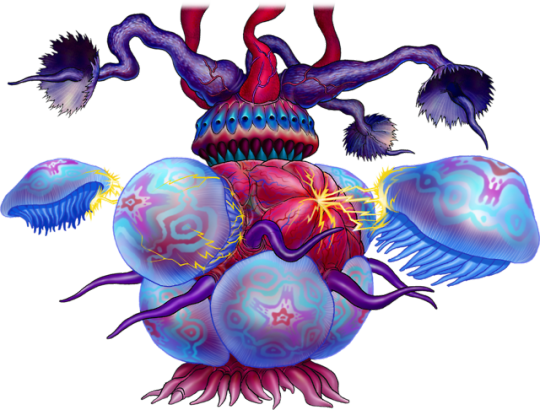
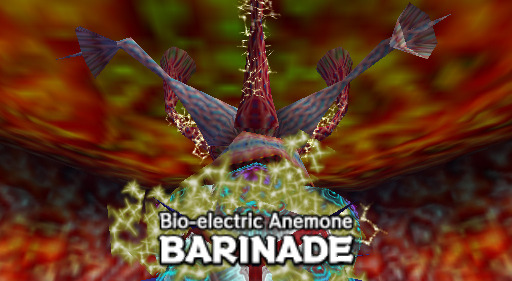
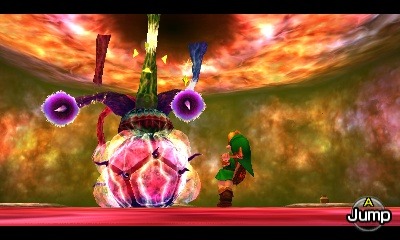

Barinade — The Legend of Zelda: Ocarina of Time
“Giant intestinal parasite with electrical powers” is a strange choice for a boss in a fantasy game, but it’s definitely an interesting one. Some real sea anemones are parasitic but their hosts are usually jellyfish, whereas Barinade lives inside of Jabu Jabu, OOT’s giant fish deity.
Despite the game’s description, Barinade only loosely resembles a sea anemone beyond simply being a fleshy mass with tentacles. It seems to be more themed around Cnidaria in general, considering its relationship to the Bari (Ocarina of Time’s jellyfish monsters) which park themselves all over its body. It whirls around like a fleshy carousel, firing bolts of electricity and sending out jellyfish to attack. Barinade’s electricity-firing tentacles have cup-like fringes around their tips, making them look like old-fashioned sci-fi rayguns.
390 notes
·
View notes
Text
Quick notice that this blog will no longer be updating biweekly and will be changing to a “whenever I feel like it” schedule. Not stopping, just slowing down because I have other things to do.
4 notes
·
View notes
Photo

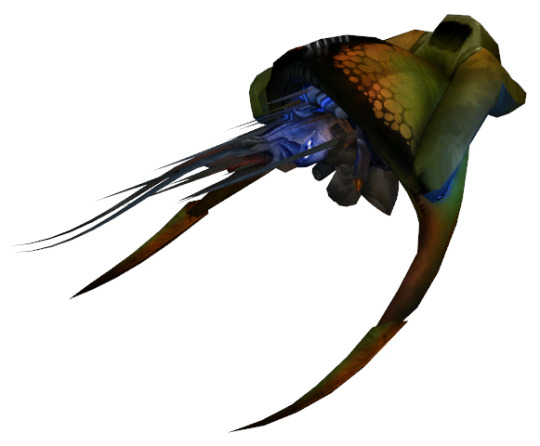

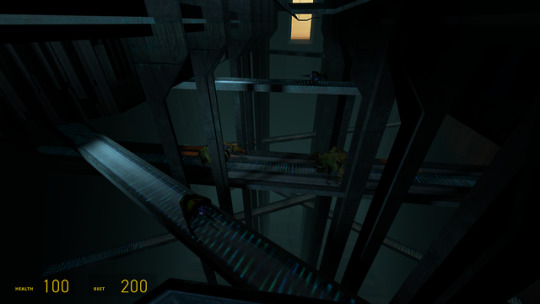
Crab Synth & Mortar Synth — Half-Life 2
Near the very end of Half-Life 2, Gordon Freeman is riding a pod up to the top of the Citadel and the player is treated to many views of the Combine forces preparing for battle. Near the end of this trip, a few strange greenish-brown units can briefly be seen moving along one particular set of walkways, and these units are never seen anywhere else in the series. These Combine units, the Crab Synth and the Mortar Synth, are actually two unfinished enemies from earlier in the game’s development.
It’s hard to critique these creatures in-depth, given that they only appear for a few seconds and don’t really do anything significant, but their simple presence really helps to give the Combine a sense of scale far beyond what the player is seeing. I think the fact that they don’t quite match the style of the other Combine units only makes them more mysterious. It gives the impression not just that there are other Combine synths that you haven’t seen, but perhaps entire classes of synths. It’s a smart way to repurpose the kind of ‘scraps’ that may not actually end up working in a gameplay context.
25 notes
·
View notes
Photo

Telefawn — Citizens of Earth
Citizens of Earth is a quirky 2015 RPG with some fun creature design that has a bit of an absurd Earthbound-esque quality to it. The Telefawn is one of the game’s earliest enemies, and it is just what it sounds like.
The design’s primary visual pun is the resemblance between the antlers of a young deer and the holster for the receiver of an old-fashioned landline telephone. The coiled cord is the creature’s tail, which is a nice secondary detail that ties the whole thing together. The receiver is the same colour as its hooves, which helps to distinguish it from the body without overcomplicating the colour palette.
It has a physical attack called “Long Distance Charge”. That’s adorable.
15 notes
·
View notes
Photo


Maneater Shell — Dark Souls
A giant, spiky bivalve with spindly legs, full of human skulls in place of pearls.
Although this creature’s five jointed legs are very different from anything found on real bivalves, their fleshy, tan colour gives them some resemblance to soft elements like the siphons or feet. They bend like human legs, but with an extra segment at the top to compensate for the lack of a hip.
The serrated shell edge is also unlike that of any naturally occurring bivalve, although some oysters have rows of spines similar to those on top of the Maneater Shell.
121 notes
·
View notes
Photo

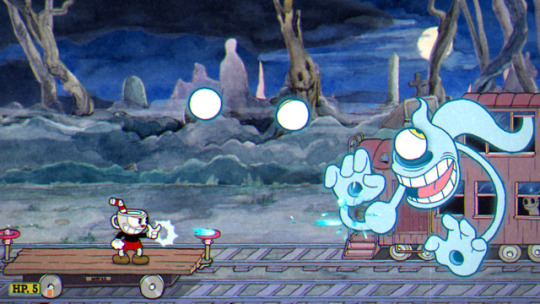
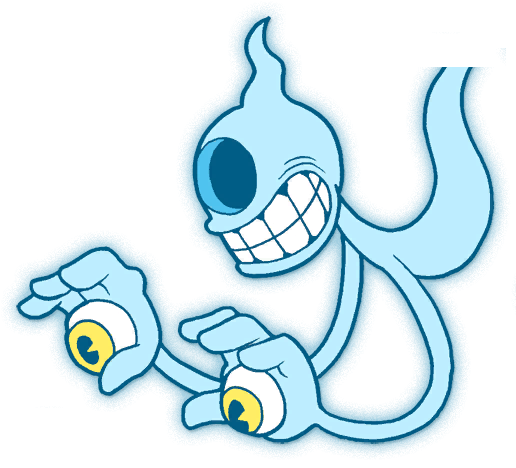
Blind Specter — Cuphead
Cuphead is an homage to Treasure’s run-and-gun games of the mid-90′s and film animation of the 1920′s and 30′s. The visual gags in this early era of animation tended to be more abstract, as filmmakers used the medium to explore all kinds of humorous ideas that had been impossible to achieve in live-action film. Cuphead’s creators have explained that this aesthetic made it easier to design enemies with bizarre, nonsensical attack patterns that still fit the visual style.
The Blind Specter probably takes at least some aesthetic inspiration from Fleischer Studios’ Swing You Sinners!. The “eyes-in-hands” design goes back to the Tenome of Japanese folklore, although it has arguably been popularized by newer creatures like the Pale Man from Pan’s Labyrinth, or various bosses from the Mario and Zelda franchises.
The animation on the Blind Specter is by Jake Clark. You can see the original pencils on his Tumblr HERE.
20 notes
·
View notes
Photo
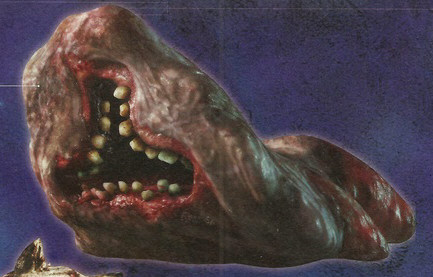
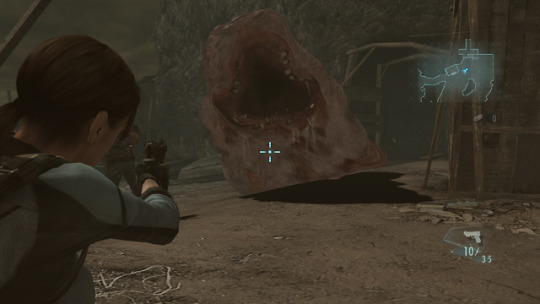
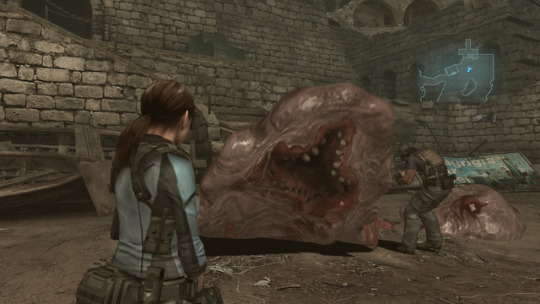
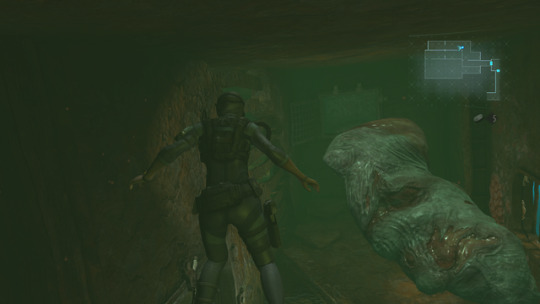
Globster — Resident Evil: Revelations
I think that one of the most effective tools in horror is the simple implication that a very inhuman creature or object used to be human. It forces the viewer to either feel a degree of uncomfortable empathy for the creature, or to consider the gruesome process by which the creature came to be.
In reality, a ‘globster’ is a hard-to-identify mass of meat that washes ashore, often the half-decomposed remains of a squid, whale, or other large sea creature. Near the beginning of Resident Evil: Revelations, protagonist Jill Valentine is tasked with analysing globsters on a beach. These ones are mutant shipwreck victims. One of the largest turns out to be alive and tries to attack when the player approaches, which is a pretty good jump scare. A second one bursts out of a shack soon after. They are big, but slow and easy to fight.
They reappear as a greater threat later in the game when Jill is forced to scuba dive through the wrecked ship. Here it is revealed that they are actually pretty good swimmers that can kill the player instantly in an underwater environment.
27 notes
·
View notes
Photo
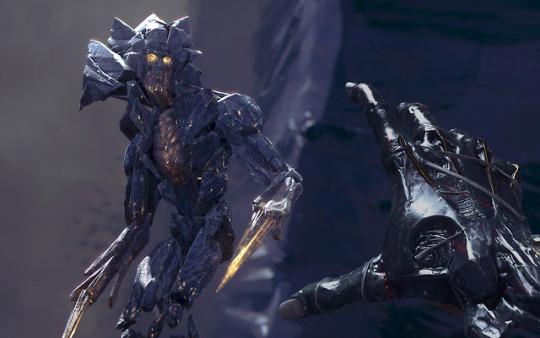




The Envisioned — Dishonored: Death of The Outsider
In Dishonored, the Envisioned are cultists that have been gradually transformed into powerful monsters through exposure to The Void. The cultists are slowly overgrown by patches of the Void’s black rock, until it eventually consumes their entire bodies. The Envisioned are greatly respected by the other cultists, but do not even acknowledge them in return. They seem to exist for the sole purpose of defending the Ritual Hold from interlopers who would seek to harm the Outsider, Dishonored’s semi-deific agent of chaos.
They are slow, but strong. Their abilities include teleportation over short distances, and the ability to summon smaller rock monsters called Void Effigies from the bodies of dead cultists.
My favourite part of their design is the effects work surrounding their legs. The world around their lower legs appears blurred and full of glowing sparks. They leave transient chunks of stone behind as they walk, almost as if their shins are breaking off and reforming with each step.
#dishonored#death of the outsider#creature design#video games#bethesda#arkane studios#dishonored spoilers
181 notes
·
View notes
Photo



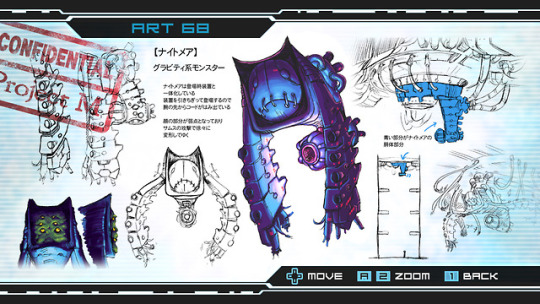
Nightmare — Metroid Fusion
A biomechanical weapon prototype capable of manipulating gravity. None of its biological parts are visible initially, but after taking enough damage a green sludge will begin dripping from the eyes in its mask. Eventually the mask is destroyed, revealing a slumping, miserable green face with six eyes. This face turns redder and slumps further as the battle progresses, acting as an approximate indicator of the boss’ health.
Nightmare hovers above the ground and attacks primarily through the cannons on the front-facing surface of its arms. When it activates its gravity-manipulating powers, Samus’ jump height is dramatically reduced and any missiles that she attempts to fire will drop out of the air and land at her feet.
Nightmare’s arms don’t really move much in Metroid Fusion, but their articulations allow them to have a bit of an organic bouncing motion, which gives them some extra visual interest. Its right arm is one segment longer than its left, and both end in broken, finger-like tubes, giving it a bit of a “mechanical zombie” appearance.
61 notes
·
View notes
Photo


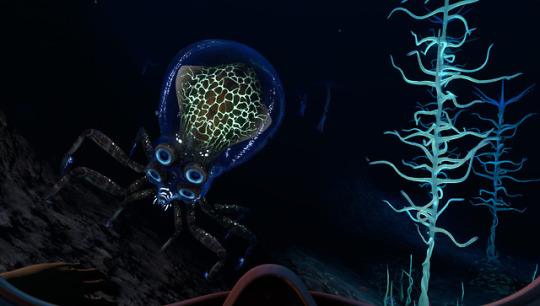

Crabsquid — Subnautica
In Subnautica, the Crabsquid is a large, bioluminescent predator that patrols relatively deep waters. It is attracted to light and it has the unique ability to produce EMP blasts which can temporarily disable the player’s electronics.
The Crabsquid is one of the few aggressive creatures in Subnautica that isn’t especially fish-like, which makes it a bit more unsettling when first encountered. It has crab-like limbs and a squid-like body with a jellyfish-like outer membrane. Inside this membrane, it has four big, squid-like eyes which are attached by stalks to its ‘mantle’.
The 3D model for the creature was built by Fox3D and can be seen on the company’s Sketchfab account HERE
41 notes
·
View notes
Photo

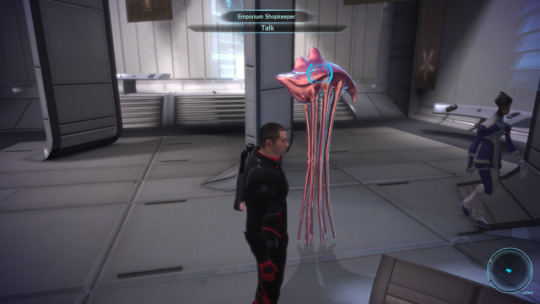
Hanar — Mass Effect
Much like on film, there are pragmatic reasons to make intelligent creatures humanoid in video games, particularly in large-scale RPG’s like Skyrim and Mass Effect. If multiple races share the same basic body shape, then they can share the same rigging and animations, saving huge amounts of time and effort for the development team. The Hanar are one of the few races in Mass Effect that are not at all humanoid. They don’t move around much and don’t participate in combat, so they don’t really need to borrow any of the usual NPC animations. Mostly they just stand around on the Citadel, proselytizing and striking deals with passersby. It’s probable that the Hanar (and the Elcor) are so sedentary simply because the team at BioWare didn’t have the time or resources to give them a more exciting variety of animations, but it’s definitely preferable to a complete lack of non-humanoid races.
A Hanar looks a lot like a Portuguese man o’ war, except it can stand on its tentacles (with some mechanical anti-gravity assistance, according to the in-game codex). Their bright colouration, soft bodies, and exceedingly polite mannerisms make them somewhat eerie but clearly non-threatening, even though they stand taller than any of the game’s humanoid species. None of the non-humanoid NPCs in Mass Effect have complicated facial animations, but the front tip of a Hanar’s body lights up when it speaks, which fits pretty well with their invertebrate sea creature aesthetic.
42 notes
·
View notes
Photo




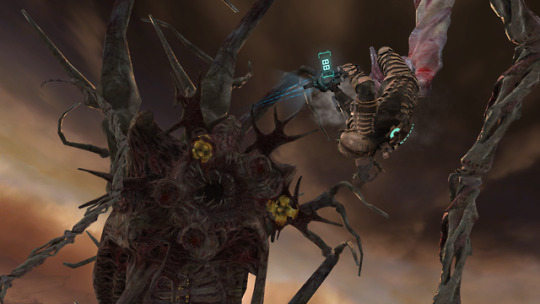
The Hive Mind — Dead Space
Dead Space’s Necromorphs are pure body horror: They are humans that have been torn up, reassembled and otherwise mutated into a variety of exceedingly gory monsters by an alien infection. The majority of the game is spent carefully creeping around a derelict space station, suspicious of potential ambushes behind every air vent and around every corner, but the game also breaks up the tension with a few setpiece battles against larger Necromorphs that take on a more action-packed tone. For the final boss battle, the game trades creeping dread for bombast as Isaac is pitted against a colossal alien monster made of several tonnes of scrambled human meat.
The Hive Mind exhibits several oft-criticized mid-2000′s sci-fi design tropes. It’s very extreme and cinematic, all rust reds and muddy browns, and it has all of the difficult-to-parse geometric complexity of a robot from one of the Michael Bay Transformers films. That said, I think these features actually work pretty well in this context, giving it a suitably messy look without losing visual priority. Atmospheric fog and huge, sweeping movements make the dangerous tentacles stand out clearly in front of the body, while its weak points stand out due to their yellow colour.
Its almost complete lack of human features diminishes the body horror in its design, which is fitting given that there is little to no ‘horror’ in the gameplay here (no running or hiding, just dodging and shooting). Despite this, it is probably still more threatening-looking than any other enemy in the game, owing mostly to its size. The jagged, thorn-like teeth give it an extra touch of viciousness.
23 notes
·
View notes